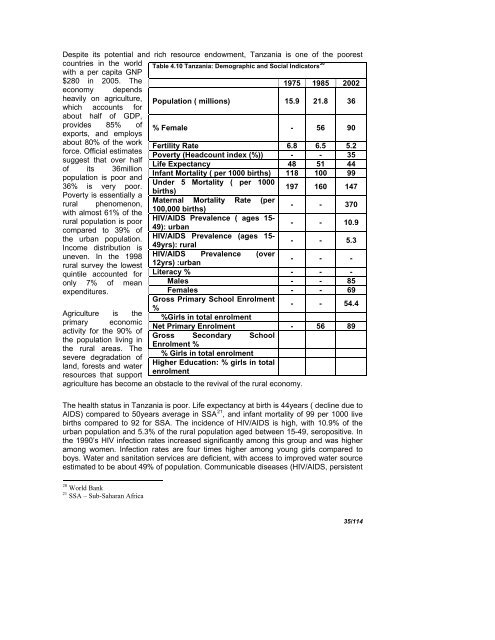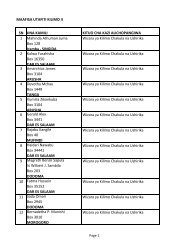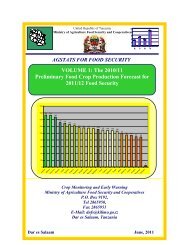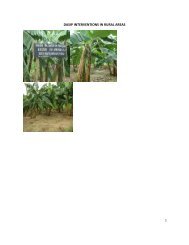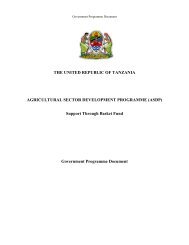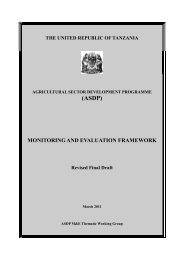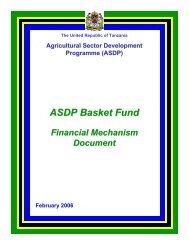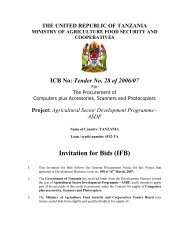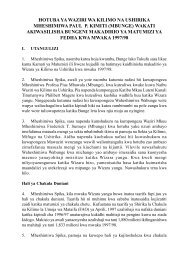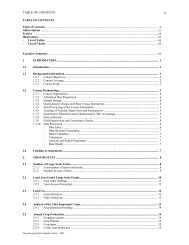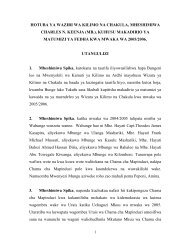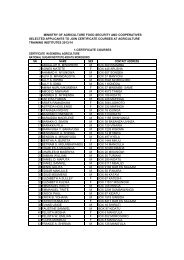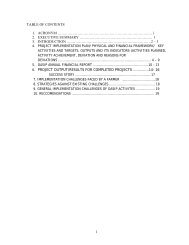ASDP: Environmental And Social Management Framework
ASDP: Environmental And Social Management Framework
ASDP: Environmental And Social Management Framework
- No tags were found...
Create successful ePaper yourself
Turn your PDF publications into a flip-book with our unique Google optimized e-Paper software.
Despite its potential and rich resource endowment, Tanzania is one of the poorestcountries in the worldwith a per capita GNPTable 4.10 Tanzania: Demographic and <strong>Social</strong> Indicators 20$280 in 2005. Theeconomy dependsheavily on agriculture,which accounts forPopulation ( millions)197515.9198521.8200236about half of GDP,provides 85% ofexports, and employs% Female - 56 90about 80% of the workFertility Rate 6.8 6.5 5.2force. Official estimatesPoverty (Headcount index (%)) - - 35suggest that over halfLife Expectancy 48 51 44of its 36millionInfant Mortality ( per 1000 births) 118 100 99population is poor andUnder 5 Mortality ( per 100036% is very poor.197 160 147births)Poverty is essentially arural phenomenon,Maternal Mortality Rate (per- - 370with almost 61% of the100,000 births)rural population is poorHIV/AIDS Prevalence ( ages 15-- - 10.9compared to 39% of49): urbanthe urban population. HIV/AIDS Prevalence (ages 15-- - 5.3Income distribution is 49yrs): ruraluneven. In the 1998 HIV/AIDS Prevalence (over- - -rural survey the lowest 12yrs) :urbanquintile accounted for Literacy % - - -only 7% of mean Males - - 85expenditures.Females - - 69Gross Primary School Enrolment- - 54.4%Agriculture is the%Girls in total enrolmentprimary economicNet Primary Enrolment - 56 89activity for the 90% ofGross Secondary Schoolthe population living inEnrolment %the rural areas. The% Girls in total enrolmentsevere degradation ofland, forests and waterHigher Education: % girls in totalresources that supportenrolmentagriculture has become an obstacle to the revival of the rural economy.The health status in Tanzania is poor. Life expectancy at birth is 44years ( decline due toAIDS) compared to 50years average in SSA 21 , and infant mortality of 99 per 1000 livebirths compared to 92 for SSA. The incidence of HIV/AIDS is high, with 10.9% of theurban population and 5.3% of the rural population aged between 15-49, seropositive. Inthe 1990’s HIV infection rates increased significantly among this group and was higheramong women. Infection rates are four times higher among young girls compared toboys. Water and sanitation services are deficient, with access to improved water sourceestimated to be about 49% of population. Communicable diseases (HIV/AIDS, persistent20 World Bank21 SSA – Sub-Saharan Africa35/114


